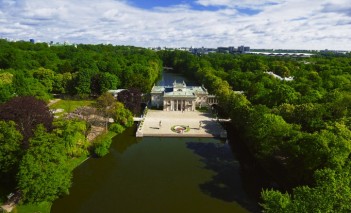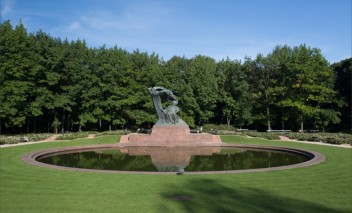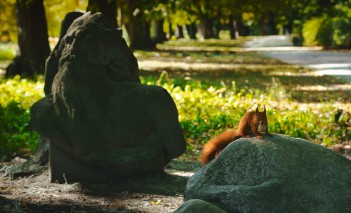The oldest trees of the Royal Łazienki

European ash, which grows in the Romantic Garden near the Belvedere Pond, is likely the oldest tree in the Royal Łazienki. Its age is estimated at 200 years. The European larch and pedunculate oak trees are equally ancient.
Deciduous trees predominate in the Royal Łazienki gardens. They have surpassed conifers, which are less resistant to atmospheric pollution and anomalies of the hydrological cycle.
Three of five oldest specimen in the Łazienki gardens are deciduous trees. The European ash (Fraxinus excelsior) which is 36 metres tall and has 420 centimetres in circumference, growing in the Romantic Garden near the Belvedere Pond, is approx. 220 years old and most likely originates from the first historical plantings. The tree has entered into the senile phase of development, which is evidenced by its sparse crown and internal decay at the base of the trunk.
The European larch trees (Larix decidua), which are equally ancient, grow near the Water Tower and at the bottom of the escarpment. Their age is estimated at approx. 200 years (larch plantings were mentioned in as early as 18th century gardening books). The European larch is the only Polish-native coniferous tree which loses its leaves in winter, and its balsamic resin makes its wood exceptionally valuable.
For almost two centuries, two specimen of the European oak have grown in the Romantic Garden. They are 450 centimetres in circumference and 28 metres high. Both are precious natural monuments.


Impressive Sizes
Although the silver poplar (Populus alba) growing to the north of the New Orangery is not among the oldest trees, it has the highest circumference among all trees in the Łazienki gardens. It has been measured at 730 centimetres. The tree’s crown is spread out and irregular. It was secured in the 1950s with half clamps, and in the 1980s, the crown was strengthened with non-invasive dynamic cabling.
Another monumental tree is the European white elm (Ulmus laevis), which grows in a group of trees near the driveway of the Myślewicki Palace. At the height of approx. 15 metres, its trunk branches out into three branches. Several hollows in its trunk indicate an advanced stage of internal decay and old age of the tree.
Sycamores (Acer pseudoplatanus) growing among serbian spruce trees on the east escarpment, by the Temple of Sybil, also exhibit impressive dendrological parameters (circumference – approx. 300 cm, height – up to 32 m). It is a Polish-native forest tree species, characterized by scale-like, protruding bark.
Colourful Compositions
The younger trees of the Łazienki gardens grow in interesting arrangements. Specimen of the Tsarist variety of the Berlin poplar (Populus x berolinensis “Petrowskiana”) occupy the central strip of the lawn on the Royal Promenade. The monumental tree is a remnant from pre-war plantings made in this area of the Royal Garden.
In the Romantic Garden, it is worth paying attention to the European beech (Fagus sylvatica), especially in autumn, when the tree’s leaves change their colour to bright yellow, and gingkgo biloba – a foreign species which has became a permanent element of the Royal Łazienki landscape. Its picturesque appearance is emphasised by the neighbouring group of dark conifer trees and the mountain ash, which bares fruit in autumn.
The purple variety of the European beech (Fagus sylvatica ‘Atropunicea’) forms a truly scenic view in conjunction with the Palace on the Isle. The ancient tree has reached a majestic size and its crown has a wide, spheric shape. The leaves maintain their strong, red colour throughout almost the entire growing season.
Horse-chestnut trees (Aesculus hippocastanum) expand into picturesque espaliers along both shores of the North Pond (looking in the direction of the Palace on the Isle from the Royal Bridge, and vice versa). Trees of this species were planted in the Łazienki gardens after World War II, in reference to the Statue of Jan III Sobieski, which stood on the Royal Bridge in the times of Stanisław August. The Royal Łazienki forest stand is abundant with the horse-chestnut, which is presumably related historically with Jan III Sobieski, who is credited with bringing this species to Poland.
The naturalistic part of the Modernist Garden is adorned with serbian spruces (Picea omorika). These dark, conical shaped trees are an excellent background for the blooming apple, pear and plum trees.










